Shaping and maintaining your hedge trimmer blades is an important part of keeping them in optimal condition. Sharpening the blades on a regular basis will help to ensure that they’re able to cut through hedges quickly, efficiently, and evenly. Fortunately, sharpening hedge trimmer blades is a relatively simple process that can be done with basic tools found around the house. Read on for more information about how to sharpen your hedge trimmer blades!
Table of Contents
How To Tell If Your Hedge Trimmer Needs Sharpening
Before you sharpen your hedge trimmer blades, it’s important to determine whether or not they are already sharp. If the blades are sharp, additional honing might actually decrease their effectiveness and cause them to become blunt faster. To check if your hedge trimmer needs sharpening, try cutting through a few twigs of similar thickness. If the blades struggle to make the cut or produce a jagged edge instead of a clean cut, it’s probably time to sharpen them.
Branches Keep Getting Jammed In The Trimmer
The first sign that your hedge trimmer blades may need sharpening is if you notice branches getting jammed in the trimmer as you use it. If this happens, it’s an indication that the blades aren’t cutting through the hedges cleanly and efficiently.
Branches Are Not Cut Cleanly
If you notice that your hedge trimmer is not cutting the branches cleanly then it could be due to a dull blade. A dull blade will pull at a branch as it cuts, resulting in an uneven and ragged cut. To remedy this problem, sharpening your blades should be done regularly with either a file or emery cloth. [1]
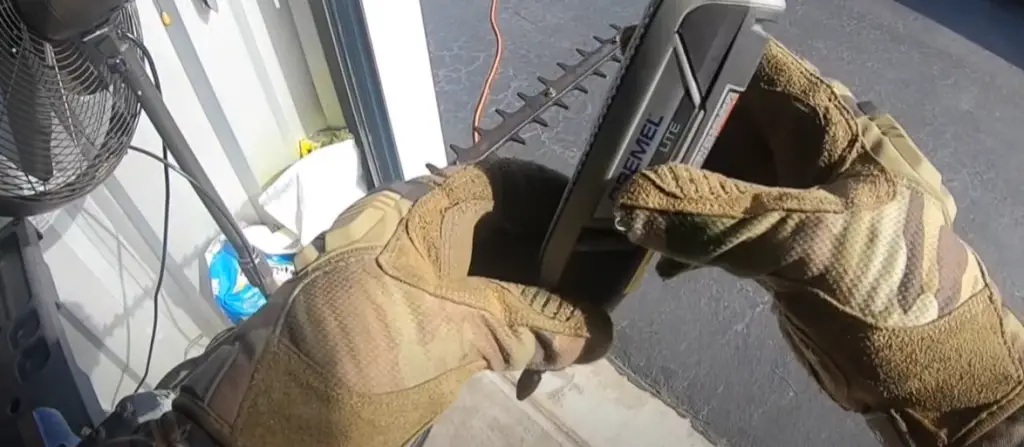
Should I Sharpen My Hedge Trimmer At Home Or Take It To A Professional?
Sharpening hedge trimmer blades can be a tricky job, and it is not recommended to attempt it at home unless you have experience in sharpening tools. If you are a novice, it is important to take your hedge trimmer to a professional who is experienced in sharpening tools. This will ensure that the blades are properly sharpened, maximizing their effectiveness and ensuring that they remain in good condition for a longer period of time. Professional sharpening services will also be able to sharpen the blades more quickly than someone who is unfamiliar with sharpening tools, meaning it won’t take as much time or money.
If you decide to attempt to sharpen your hedge trimmer blades at home, make sure you have all the necessary tools for the job. This may include a whetstone or file, as well as protective gloves and glasses to protect your eyes and hands from any sharp pieces of metal that could be sent flying from the force of sharpening. [2]
How To Sharpen A Hedge Trimmer With A Mill File
A mill file is a handy tool for sharpening the blades of a hedge trimmer. The process is not difficult, but it does require some patience and care in order to get the job done correctly.
Before you begin sharpening your hedge trimmer, make sure to unplug it or remove any batteries that may be powering it. This will prevent any accidental start-ups while you work.
Now, take your mill file and open it up so that the two sides are touching each other. Start by placing one of the blades between the two surfaces and begin running them along its edges in a forward and back motion. This will help remove any dullness or burrs that may have developed on the blade due to regular use.
How To Sharpen A Hedge Trimmer With A Power Grinder
If you want to sharpen the blades of a hedge trimmer with a power grinder, here’s what you need to do:
- Start by cleaning off any dirt or debris from the blade with a wire brush and protect your eyes and hands with safety equipment like goggles and gloves.
- Use a flat file to remove any nicks or imperfections from the blades. Move the file in one direction and keep it as consistent as possible.
- Now, with a grinding wheel attached to your power grinder, begin to sharpen the blade. Start at the base of the blade and move up, making sure that the angle of the grinding wheel matches the angle of the blade.
- As you sharpen, periodically check to make sure that the blade is evenly sharpened by running your finger lightly along its edge.
- When finished, use a fine file and some oil to finish off the blade. Move in one direction with the file to create a smooth, polished surface.
- Finally, check the blade for sharpness and balance by setting it on a flat surface. If it wobbles or is not evenly sharpened, repeat steps 3-5 until you get the desired results.
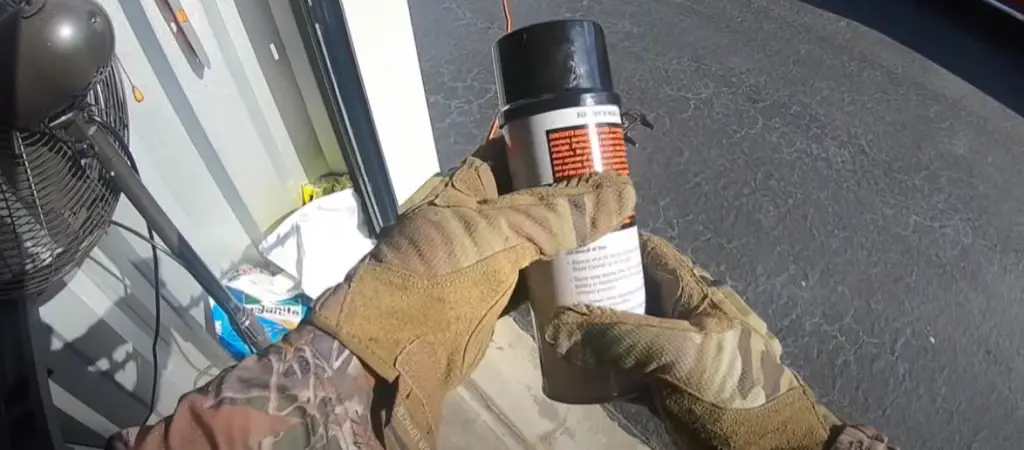
How To Sharpen A Hedge Trimmer Using Dremel
When sharpening your hedge trimmer blades, it is always recommended to use a rotary tool such as a Dremel. Using a Dremel allows you to sharpen all sides of the blade evenly and can significantly reduce the time needed for sharpening compared to other methods.
Before beginning, make sure that your power tool is plugged in and the blade is securely mounted on a bench vice. It’s also important to wear protective eyewear to protect from sparks or dust.
To begin, select a grinding stone bit for your Dremel and attach it to the tool. Ensure that the side of the grinding stone you choose matches the shape of the blade. You will then need to set the speed of your Dremel. For sharpening a hedge trimmer, it’s best to use a low-to-medium setting.
When you have finished grinding, check that the edges of your hedge trimmer blades are sharp and even. If there are any rough spots on the blades, you can use a fine-grit sandpaper to smooth these out. [3]
Important Safety Precautions
It is important to observe safety precautions while sharpening hedge trimmer blades. Always wear eye protection when working with power tools, and make sure the area around you is clear of other people or objects. Additionally, make sure your hedge trimmer is unplugged and disconnected from its power source before attempting to work on it. Make sure the trimmer blades are cool to the touch before starting, as a hot blade could cause serious burns. Check that all screws, nuts and bolts are firmly in place and secure them if necessary. Finally, make sure your hands are dry and wear work gloves or other protective gear when handling sharpened trimmer blades. Following these safety precautions will help ensure you have a safe and successful sharpening experience. [4]

Tips for sharpening a hedge trimmer blade
- Make sure the blades are cool to the touch before sharpening as heat can damage the blade and make it more difficult to sharpen.
- Remove any debris, grass clippings or dirt from the blades with a cloth or brush. This will ensure that you get an even and effective sharpening job on all of the blades.
- Select the right type of sharpening stone and lubricant for your hedge trimmer blades, such as an oil or waterstone. Be sure to follow the instructions provided on the packaging carefully.
- Place the blade against the stone at a 30-degree angle and gently move it in a back-and-forth motion. Keep the angles consistent to ensure an even sharpening job.
- Move across the blade in a continuous pattern, working from the base of the blade down towards its tip until you achieve your desired level of sharpness.
- Test out your newly sharpened blades by cutting through a piece of paper or cardboard. If the blades are sharp enough, they should cut through easily.
- Once you have achieved your desired level of sharpness, apply a light coating of lubricant to both sides of the blade and then wipe it off with a clean cloth or paper towel. This will help prevent rusting and keep your hedge trimmer blades in top condition.
- When you are finished, make sure to store your hedge trimmer blades safely and securely in a dry and cool location. This will help ensure that they remain sharp for longer periods of time.
FAQ
How do you sharpen trimmer blades?
Using a file or rotary tool, sharpen the blade by following the angle of the cutting edge. Then, deburr the side edges with a diamond stone or piece of sandpaper. A few strokes are usually enough for regular maintenance sharpening. If necessary, you can use an electric grinder to quickly sharpen blades with extensive damage.
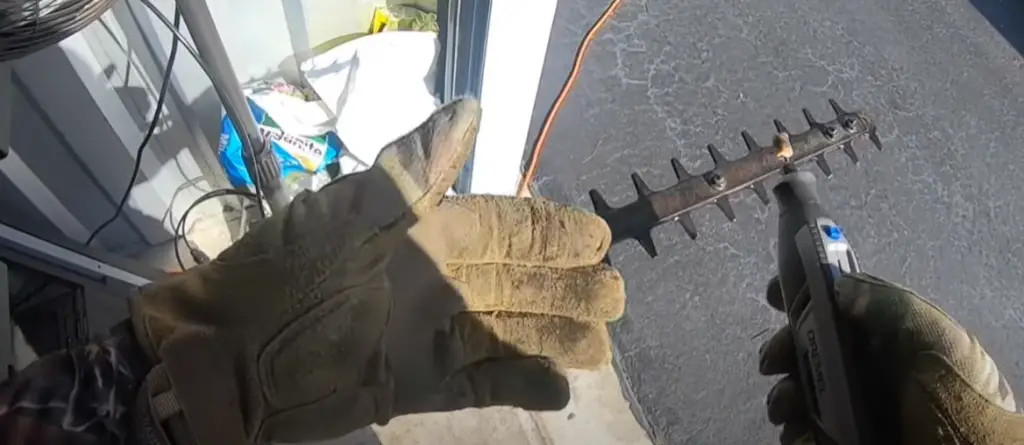
How do you sharpen hand hedge trimmers?
Sharpening hand hedge trimmers is a relatively easy task that can be done at home with the right tools. The main tool needed to sharpen hand hedge trimmers is a file or stone. You will also need some oil, cloth and safety glasses for eye protection. To begin, remove the blades from the trimmer and lay them on a flat surface.
How often should you sharpen hedge trimmer blades?
You should sharpen your hedge trimmer blades at least once a season, but depending on how often the tool is used, it may need sharpening more frequently. Dull blades will tear or crush branches and twigs instead of cutting cleanly. Therefore, it’s important to inspect your hedge trimmer blades before each use and sharpen them as necessary.
Is WD-40 good for hedge trimmer blades?
No, WD-40 is not good for hedge trimmer blades. WD-40 can help protect metal parts from rust and corrosion, it does not provide the necessary action needed to keep a blade sharp. In fact, using WD-40 on your trimmers can make them less efficient as it will attract dirt and debris which can make it difficult to clean the blades. Instead, use a fine-grit sharpening stone or a diamond file to sharpen your trimmer blades. Make sure to always wear protective gear while doing so, as the debris and metal filings can be dangerous if they get in your eyes or skin.
How do you clean and sharpen electric hedge trimmers?
Electric hedge trimmers require a different cleaning and sharpening process than those powered by gas or manual power sources. The blades of electric hedge shears need to be checked regularly and, if necessary, cleaned and sharpened. Here are some steps to get your electric hedge shears back in shape:
- Remove debris. Carefully remove any dirt, grass clippings or other debris that may have collected on the blades of your electric hedge trimmer. You can use a soft brush to do this.
- Clean with soapy water. Next, mix a solution of warm water and mild soap in a bucket. Carefully dip the blades into the solution and scrub them gently with a soft brush. Make sure to get into the grooves of the blades. Rinse with clean water afterwards.
- Sharpen the trimmer blades. You can use a file or an electric sharpener specifically designed for hedge trimmers to sharpen the blades of your electric shears. Start by filing each blade individually in one direction using a back-and-forth motion. Do this until the blades are sharp and even. Then, switch directions and repeat the process until you are satisfied with the blade’s edge.
- Reassemble the trimmer after sharpening. Put the electric hedge trimmer back together in its original form according to manufacturer guidelines. Be careful not to overtighten any screws or bolts.
How much does it cost to sharpen hedge trimmers?
The cost of sharpening hedge trimmer blades varies depending on the type, model and brand of your hedge trimmer. It can range anywhere from $8 to $35 on average. Some local lawnmower or small engine shops may offer special discounts if you bring in multiple tools for sharpening at once. Additionally, some online retailers sell sharpening kits that contain all the tools you need to sharpen your blades.
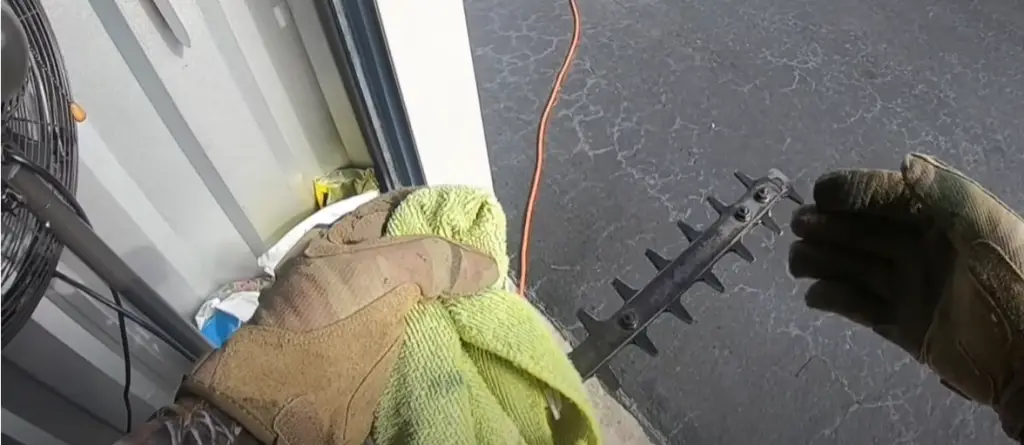
What kind of file do you use to sharpen hedge trimmer blades?
When it comes to sharpening hedge trimmer blades, the best tool for the job is a mill bastard file. This type of file has a coarse surface with medium-sized teeth designed specifically for this task. It’s important to choose a size that corresponds with your blade and angle requirements. For instance, if you have small blades or need to sharpen at a specific angle, you’ll want to choose a smaller file. If you have large blades, however, or don’t have any particular angle requirements, then a larger file would be better suited for the job.
Can you sharpen clipper blades with sandpaper?
Yes, you can sharpen your clipper blades with sandpaper. You will need to use a fine-grit sandpaper—400 grit or finer is best. Start by laying the sandpaper flat on a surface and placing the blade on top of it. Using slow back-and-forth strokes, rub the blade across the sand paper in the same direction that it cuts. To ensure you don’t dull the blade, be sure to lift it off of the sandpaper as you move it back and forth across the surface. If you notice any burrs or nicks on your blades, use a whetstone to smooth them out. After each pass with the sandpaper, use a clean cloth to wipe away any shavings. Once you’ve finished sharpening your blades with the sandpaper, you can use an oiled rag and honing compound to give them a polished finish. By following these steps, you can sharpen both regular and serrated clipper blades quickly and easily.
Do hedge trimmers get dull?
Yes, hedge trimmers can become dull over time with regular use. Unfortunately, the blades of a hedge trimmer aren’t something you can easily sharpen at home like scissors or knives. The blades are made from hardened steel and require special tools and techniques to properly sharpen them. If your hedge trimmer is starting to get dull or isn’t cutting as well as it used to, then it’s time to take it to a professional for sharpening.
Useful Video: How to Sharpen Hedge Trimmers the pro way
Conclusion
In conclusion, sharpening hedge trimmer blades is an essential part of regular maintenance and upkeep. Doing it properly can help extend the life of your hedge trimmer and ensure its continued effective performance. With a few simple steps, you too can sharpen the blades of your hedge trimmer easily and quickly. Make sure to follow safety precautions when working with your hedge trimmer and be sure to wear protective gear. Doing regular maintenance like sharpening the blades will ensure that your hedge trimmer is always operating at its best. With proper care and maintenance, you can enjoy many years of trouble-free use from your hedge trimmer. Now that you know how to sharpen hedge trimmer blades, you can start taking better care of your hedge trimmer and keep it in tip-top shape.
References:
- https://www.stihl.com/hedge-trimmer-sharpening
- https://www.gardentoolbox.co.uk/news/how-to-sharpen-and-clean-electric-hedge-trimmer-blades/
- https://backyardgadget.com/how-to-sharpen-hedge-trimmer/
- https://www.hutsoninc.com/blog/sharpen-hedge-trimmers/

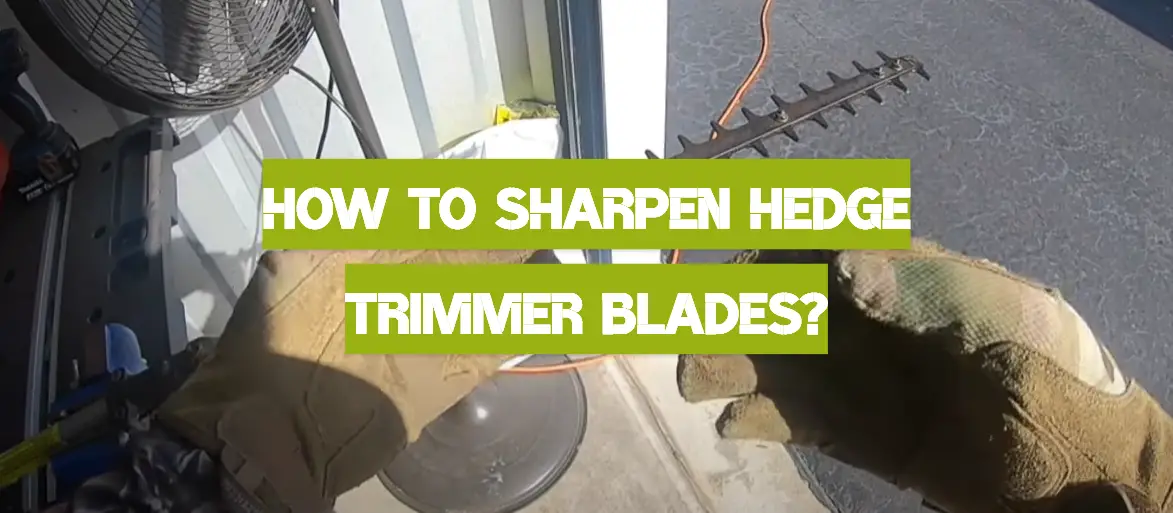



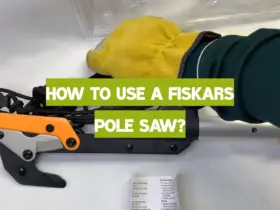

Leave a Reply